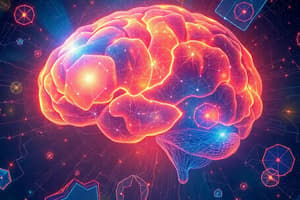Podcast
Questions and Answers
What type of attention prioritizes areas or objects for action, such as eye movements?
What type of attention prioritizes areas or objects for action, such as eye movements?
- Selective attention
- Overt attention
- Divided attention
- Covert attention (correct)
What is the capacity of verbal short-term memory (STM)?
What is the capacity of verbal short-term memory (STM)?
- 9 ± 2
- 11 ± 2
- 7 ± 2 (correct)
- 5 ± 2
What is the effect of covert attention on spatial acuity at uncued locations?
What is the effect of covert attention on spatial acuity at uncued locations?
- It decreases spatial acuity (correct)
- It increases spatial acuity
- It has no effect on spatial acuity
- It only affects spatial acuity at cued locations
What is the purpose of the exogenous cue in the study by Dosher and Lu?
What is the purpose of the exogenous cue in the study by Dosher and Lu?
What is the benefit of auditory spatial attention in the study by Spence and Driver?
What is the benefit of auditory spatial attention in the study by Spence and Driver?
What is the effect of selective attention on the signal-to-noise ratio?
What is the effect of selective attention on the signal-to-noise ratio?
What is the primary function of selective attention in auditory perception?
What is the primary function of selective attention in auditory perception?
What is the purpose of the study by Eramudugolla et al.?
What is the purpose of the study by Eramudugolla et al.?
What is the effect of covert spatial attention on spatial resolution?
What is the effect of covert spatial attention on spatial resolution?
Which of the following is a benefit of selective auditory attention?
Which of the following is a benefit of selective auditory attention?
What is the difference between predictive and non-predictive cues in the study by Spence and Driver?
What is the difference between predictive and non-predictive cues in the study by Spence and Driver?
What is the relationship between signal-to-noise ratio and visual perception?
What is the relationship between signal-to-noise ratio and visual perception?
What is the result of valid cueing in the study by Spence and Driver?
What is the result of valid cueing in the study by Spence and Driver?
How can age affect signal-to-noise ratio in sensory systems?
How can age affect signal-to-noise ratio in sensory systems?
What is the effect of attention on spatial acuity at cued locations?
What is the effect of attention on spatial acuity at cued locations?
What is the difference between exogenous and endogenous cues in selective attention?
What is the difference between exogenous and endogenous cues in selective attention?
What is the effect of selective attention on auditory working memory?
What is the effect of selective attention on auditory working memory?
What is the relationship between spatial attention and signal-to-noise ratio?
What is the relationship between spatial attention and signal-to-noise ratio?
What is the benefit of covert spatial attention in auditory perception?
What is the benefit of covert spatial attention in auditory perception?
What is the role of selective attention in sensory processing?
What is the role of selective attention in sensory processing?
What is the primary reason for the need for selection in attention?
What is the primary reason for the need for selection in attention?
What determines the spatial resolution of information sampled in a single fixation?
What determines the spatial resolution of information sampled in a single fixation?
What is the primary mechanism by which we decide where to fixate?
What is the primary mechanism by which we decide where to fixate?
What is the primary difference between overt and covert attention?
What is the primary difference between overt and covert attention?
What is the main constraint on the type and amount of information observers obtain from the environment?
What is the main constraint on the type and amount of information observers obtain from the environment?
What is the primary function of selective attention?
What is the primary function of selective attention?
What is the relationship between the brain's capacity for processing information and the need for selection?
What is the relationship between the brain's capacity for processing information and the need for selection?
What is the primary difference between visual and auditory attention?
What is the primary difference between visual and auditory attention?
What is the primary factor that determines what information is prioritized in selective attention?
What is the primary factor that determines what information is prioritized in selective attention?
What is the main consequence of not prioritizing a subset of information in selective attention?
What is the main consequence of not prioritizing a subset of information in selective attention?
Flashcards are hidden until you start studying
Study Notes
Selective Attention
- Definition: The process of prioritizing a subset of information from multiple sensory systems, due to physiological limits imposed by effector systems (e.g., eyes and hands).
Why Do We Need Selection?
- Brain receives information from multiple sensory systems, but not all information is relevant at any one time.
- Capacity limits associated with neural function and metabolism.
Visual Selective Attention
- Physiology of the visual system imposes constraints on the type and amount of information obtained from the environment.
- Gradient of visual acuity determines the spatial resolution of information sampled in a single fixation.
Eye Movements and Overt Attention
- Eye movements are guided by a sequence of fixations, determining where to focus attention.
- Overt attention refers to the physical act of directing attention to a specific location.
Covert Attention
- Prioritizes areas or objects for action (e.g., eye movements).
- Prioritizes information for analysis and retention.
Post-Perceptual Processes
- Working memory: a capacity-limited, temporal store (e.g., verbal STM: 7 ± 2, visual WM: uncued baseline).
Attention and Spatial Acuity
- Attention increases spatial acuity at cued locations, and decreases it at uncued locations.
- Covert attention mediates changes in spatial acuity in the absence of eye movements.
Attention and Signal-to-Noise
- Selective attention includes a "noise-exclusion" mechanism, increasing detection at cued locations by increasing the signal-to-noise ratio.
- Attention is more effective in displays with high levels of external noise.
Auditory Selective Attention
- Spatial attention can be triggered exogenously or endogenously.
- Auditory selective attention increases spatial acuity of auditory localization, increases acuity of non-spatial judgments (pitch), and protects selected items from degradation in auditory working memory.
Summary
- Selective attention is a set of processes that protect capacity-limited perceptual and post-perceptual resources.
- Shifts of spatial attention can be triggered exogenously or endogenously.
- Covert spatial attention increases spatial resolution, increases signal-to-noise ratio, and combines sensory information across modalities.
Studying That Suits You
Use AI to generate personalized quizzes and flashcards to suit your learning preferences.




